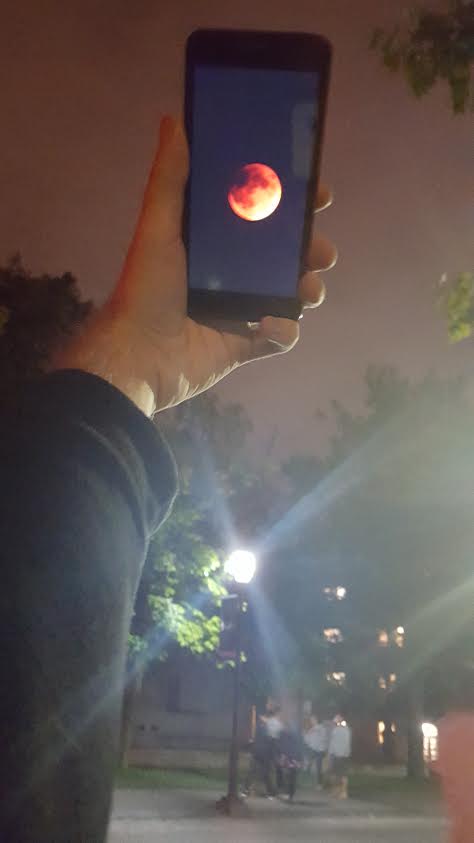Sunday, September 27, 2015 marked a rare event: a supermoon lunar eclipse. Since the 1900’s, this has only happened five times — the last sighting being in 1982. A supermoon lunar eclipse is a combination of two events that coincide at the same time. When a full moon reaches the closest distance to Earth within its elliptical orbit (a region known as the perigee), the moon appears fourteen percent larger in diameter — which is why it’s called a ‘supermoon,’ The swollen moon is the main reason why this phenomenon is so striking compared to a normal eclipse, which occurs when the Earth’s shadow blots out the moon. This positioning is also responsible for the reddish tint that the moon takes on during the eclipse.
The Dunlap Institute for Astronomy & Astrophysics in collaboration with the Department of Astronomy & Astrophysics and Science & Engineering Engagement organized a total lunar eclipse viewing party for students and anyone else who would be interested in viewing the rare astronomical event. Once the event details were available on Facebook, the event quickly gained publicity and received almost 20,000 RSVPs. To accommodate the growing number of attendees, organizers changed the location of the event to King’s College Circle, where telescopes were set up outside. “We had to completely change our plans for the event as the numbers of people ‘RSVP-ing’ climbed higher. We purchased more telescopes and had to come up with plans to handle the large crowd,” said Mike Williams, who runs U of T’s observatory and planetarium and was one of the organizers of the event.
There was extensive social media coverage of the eclipse worldwide during the days leading up to the event. From regular Twitter announcements from NASA to articles on how to capture the moon in photographs by National Geographic, it wasn’t only astronomy enthusiasts that searched the night sky hoping to catch a glimpse of the moon. “A large part of our success is [that] over the years we have been growing an audience — through previous events like [the] Neil deGrasse Tyson lecture and our transit of Venus viewing party we have built a following. The eclipse itself also got lots of media coverage,” Williams added.
Unfortunately — due to excessive cloud cover — only glimpses of the moon could be seen. However, that didn’t stop people from getting their tripods and cameras ready in the hopes of spotting it. Despite the weather, several volunteers and organizers from the Dunlap Institute were present to offer their insights and knowledge on the moon and other space-related topics. The large attendance indicates a growing interest among a variety of people pursuing different disciplines and interests. “Even though we didn’t get to see the moon because of the clouds, it was a fun night. I’m excited to go [to] other [astronomy] events,” said attendee second-year molecular biology student, Jonathan Burnie.
“It’s important for scientist[s] to take what we have learned and communicate it back to the public. Science is best when it can be used to elevate everybody’s understanding. In Canada, a lot of funding for science comes from the tax payer and so an important step in science has to be to share the knowledge that research has generated,” Williams elaborated.
“I hope people take away an appreciation for the beauty of the night sky and a wonder for the Universe. Events like the lunar eclipse where you don’t need any viewing aids like telescopes to watch it are great, because you don’t feel a disconnect from the universe around us,” Williams explained. In honour of the special lunar event, the Dunlap Institute also hosted a lunar eclipse photography contest which ended at 11:59 pm on September 30, 2015.
“I also hope people take away an appreciation for just how far our understanding of the Universe has come. We are able to accurately predict the times of these eclipses thousands of years into the future. All of this is due to a long history of looking at the sky and trying to figure out how it all works,” Williams concluded.


